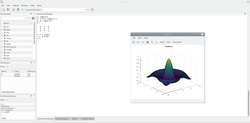| GNU Octave | |
|---|---|
 | |
 GNU Octave 4.3.0+ running on Linux | |
| Developers | John W. Eaton and many others [1] |
| Initial release | 4 January 1993 (first alpha release) 17 February 1994 (version 1.0) [2] |
| Stable release | |
| Repository | |
| Written in | C++ (main), Octave itself (scripts), C (wrapper code), Fortran (linear algebra wrapper code) [4] |
| Operating system | Windows, macOS, Linux, BSD |
| Available in | 18 languages [5] |
| Type | Scientific computing |
| License | 2007: GPL-3.0-or-later [a] 1992: GPL-2.0-or-later [b] |
| Website | https://octave.org/ |
GNU Octave is a scientific programming language for scientific computing and numerical computation. Octave helps in solving linear and nonlinear problems numerically, and for performing other numerical experiments using a language that is mostly compatible with MATLAB. It may also be used as a batch-oriented language. As part of the GNU Project, it is free software under the terms of the GNU General Public License.
Contents
- History
- Development history
- Developments
- Technical details
- Octave, the language
- Notable features
- Command and variable name completion
- Command history
- Data structures
- Short-circuit Boolean operators
- Increment and decrement operators
- Unwind-protect
- Variable-length argument lists
- Variable-length return lists
- C++ integration
- MATLAB compatibility
- Syntax compatibility
- Function compatibility
- User interfaces
- GUI applications
- Packages
- Comparison with other similar software
- See also
- Notes
- References
- Further reading
- External links